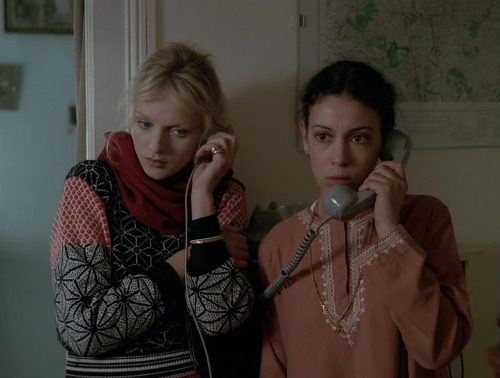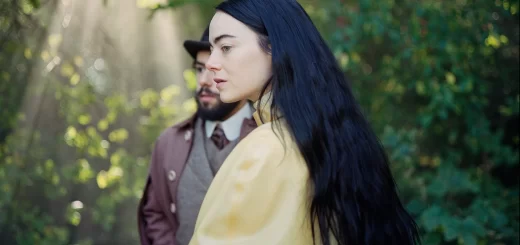Rohmerathon: A Good Marriage, by Scott Nye
The second in Eric Rohmer’s “cycle” of Comedies and Proverbs, A Good Marriage (1982) begins with the question, “Can any of us refrain from building castles in Spain?” For Sabine (Béatrice Romand), her castle is marriage. Fed up with her married boyfriend, she dumps him and declares she is soon to wed. To whom, she does not know. But she is a Rohmer protagonist and has a very definite idea, which comes more or less complete in the form of her best friend’s cousin, Edmond (André Dussolier), a thirtysomething lawyer with good manners, social standing, looks, and income. He’s terrific husband material. Unfortunately for Sabine, he knows it.
We’ve seen how Rohmer’s characters establish a version of their Best Life and engineer a plan to attain it, usually by creating circumstances under which one person will naturally come to them without having to deal with the discomfort and uncertainty of a traditional seduction. They don’t have a lot of “game”, so to speak, but recognize that a precise series of social circumstances will make coupling inevitable. Sabine assumes that if she simply spends enough time with Edmond, if she calls enough to remind him of her existence, he’ll just have to fall for her. Men are easily lead, and she is not an unappealing person. But while she correctly estimates that their age difference makes for a familiar sort of couple, she doesn’t account for how her youthful lifestyle won’t quite fit in with his thoroughly adult one. By the time she drags him out to her birthday party, where people in their late teens and early twenties are dancing about and groping one another, the viewer just about wants to claw their way out of the room from discomfort.
This is the rare time, though, when self-delusion doesn’t doesn’t pay off for a Rohmer protagonist. Jerome was able to touch Claire’s knee, the unnamed young men in Bakery Girl and My Night at Maud’s marry their blonde obsessions, the Marquise marries her white knight. All find the result less compelling than they did at first, and their dissatisfaction is vital to the narrative. But things just do not work out for Sabine. And quickly.
And this is where we get into the always-uncomfortable topic of gender. Aside from The Marquise of O, Sabine is Rohmer’s first female protagonist, and she behaves nothing at all like his men. Their cold calculation invites similarly-calculating men to identify with what happens when you take an analytical relationship approach to extremes (obsessed as they are with the possibilities of leading a dual life, I often wonder if these stories are Rohmer’s way of doing same; then again, Rohmer was basically living a dual life from the start as he changed his name and lied to his family about his involvement in cinema – a subject for another day). I’ll admit that my own interest in their single-minded pursuits comes more from experience than curiosity.
So I’m a bit stuck for how to feel about Sabine. Her pursuit of Edmond transforms extreme approach into extreme behavior, bursting into volatile emotional responses at every perceived slight and angrily retaliating at everyone around her when she doesn’t get her way. The more honest encounters seem to me to take place when Edmond tries to press her on her behavior and she spends the whole time in active denial. But then, I’ve been in Edmond’s shoes there, so naturally it seems honest. The question then is whether Sabine’s behavior is an exaggerated extension of an honest emotional appeal. Rohmer’s men are manipulative narcissists whose specific actions are more pronounced as a way of expressing an interior many men carry around. The same may be true of Sabine; I am not a woman.
But neither is Rohmer. And as we’re dealing with a marriage-hungry woman who will stop at nothing to get her man, the question of misogyny is unavoidable and necessary. Whether or not he crosses any lines is ultimately not for me to say; I don’t feel he does, others might feel differently, hey it’s art! I will say that the other major female figures in the film – the best friend (Arielle Dombasle), and Sabine’s mom (Thamila Mezbah) and boss (Huguette Faget) – all present more reasonable portraits, trying to steer Sabine back into more sensible actions and worldviews. But where would the fun be if she followed them? I prefer to watch films about people who often make the wrong decisions, who act irrationally and absurdly and strive for something they might not get. Sabine certainly fulfills that desire.
Romand made her film debut proper (she had an uncredited role in Terence Young’s 1968 Mayerling) in Claire’s Knee as Claire’s younger sister Laura, whom Jerome teases endlessly in a more-than-a-little-creepy flirtation. She acted in film and television for five more years, then took a five-year break before re-emerging in A Good Marriage. The time away does not seem to have affected her instincts or conviction. Her eyes have a way of lighting up with simultaneous desperation and purpose. Sabine was so proud of herself for deciding to be married, she can’t bear the perception that the goal is slipping away. Rohmand builds up these defensive gestures, from pursed lips to folded arms to the way she tries to end every conversation with her line as the final word. This transformation from positive self-esteem to harmful self-protection is the sort of fascinating dichotomy the HBO series Girls explores so well (how easy is it to imagine Marnie or Shosh in this exact same story?), a condition of the postmodern age Rohmer was experiencing that has only intensified as our public personas have to be maintained across many platforms, relationships, and environments.




























